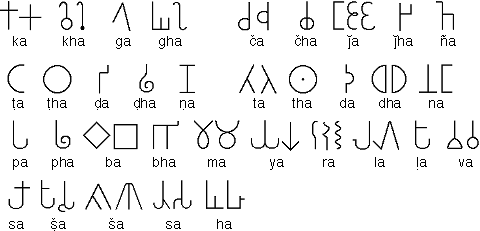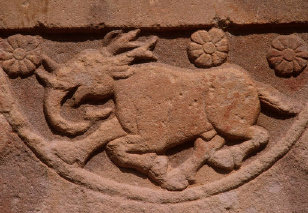Mirror: http://tinyurl.com/p4dp5xy
A 19th century account about Dhavads as blacksmiths is given in the context of census of craftsmen in Bombay Presidency, Konkan in particular:
“Of Craftsmen, there are nine classes with a strength of 11,330 souls or 6.2 per cent of the whole Hindu population. Of these 2100 were Mithgavdas, saltmakers; 175 were Koshtis, weavers, found only in the villages of Tulas and Kasal; 1380 Telis, oilmen; 1210 Sonars, goldsmiths; 2100 Kumbhars, potters; 475 Dhavads, blacksmiths; 3760 Sutars, carpenters; 30 Shimpis, tailors; and 100 Chitaris, painters. Rising Early in the morning they are soon at work and keep working till noon. After a meal and a two hours’ rest they begin again and continue till the evening, when after supper they go early to bed. All except the goldsmith are poor, and most of the saltmakers, oilmen, and weavers, and some carpenters and potters eke out their earnings by field work. Getting little help from their wives and children they carry on their work on the humblest scale with no stock in hand, and making articles only when ordered. The estimated monthly charges of a family of four persons, a man, his wife and two children, are, for a goldsmith, about Pound 1 10s. (Rs. 15); for a carpenter from 16s. to Pound 1 (Rs. 8 – Rs. 10); and for a mason from 10s. to 12s. (Rs. 5-Rs.6).” (Gazetteer of the Bombay Presidency, 1880, Volume 10, Govt. Central Press, Bombay, p.415).
The semantic evolution of the lexis related to dhāvaḍa'iron-smelters of ancient times' -- an expression also explained orthographically by strands of rope --is traceable from expressions of Indian sprachbund.
Dhavad is an expression derived from the root: धा [ dhā ] which means, 'time, turn' and is used as a suffix to signify numeral counts: एकधा, द्विधा, त्रिधा, चतुर्धा . This root semantics explains why the morphemes of the phoneme dhā- gets three meanings: 1. धाऊ [ dhāū ] m f A certain soft and red stone (which yields iron after smelting); 2. धातु [ dhātu ] 'A primary or elementary substance, a mineral'; 3. धातु [ dhātu ] in grammar 'the root of a verb.'
 The choice of 'dotted circle' in an early writing system to signify syllable tha in Brahmi is perhaps derived from the root phoneme: धा [dhā]. It is unclear if the same 'dotted circle' hieroglyph connotes the word: धाऊ [ dhāū ] m f A certain soft and red stone (which yields iron after smelting). In Indus Script decipherment the 'dotted circle' has been read rebus: kandit'bead' Rebus: kanda'fire-altar'.
The choice of 'dotted circle' in an early writing system to signify syllable tha in Brahmi is perhaps derived from the root phoneme: धा [dhā]. It is unclear if the same 'dotted circle' hieroglyph connotes the word: धाऊ [ dhāū ] m f A certain soft and red stone (which yields iron after smelting). In Indus Script decipherment the 'dotted circle' has been read rebus: kandit'bead' Rebus: kanda'fire-altar'.In Rigveda, the derived morpheme धातु [ dhātu ], derived from root dhā- is explained as 'strand of rope' or 'element': dhāˊtu n. ʻ substance ʼ RV., m. ʻ element ʼ MBh., ʻ metal, mineral, ore (esp. of a red colour) ʼ Mn., ʻ ashes of the dead ʼ lex., ʻ *strand of rope ʼ (cf.tridhāˊtu -- ʻ threefold ʼ RV., ayugdhātu -- ʻ having an uneven number of strands ʼ KātyŚr.). [√dhā ](CDIAL 6773)
 See Bogazkoy seal of 18th cent. BCE which shows three strands of rope: tridhā. Twisting wisps of fibre in three strands creates a rope. http://bharatkalyan97.blogspot.in/2015/10/indus-script-hieroglyph-twisted-rope-on.html
See Bogazkoy seal of 18th cent. BCE which shows three strands of rope: tridhā. Twisting wisps of fibre in three strands creates a rope. http://bharatkalyan97.blogspot.in/2015/10/indus-script-hieroglyph-twisted-rope-on.htmlThis hieroglyph becomes a framework for rebus-metonymy rendering of iron-worker or iron-smelter's work with धाव [ dhāva ] m f A certain soft, red stone > धातु 'minerals or ferrite ores' which were identified in three categories: magnetite, hematite, ilmenite. hence, workers with धाव [ dhāva ], धातु were called धावड [ dhāvaḍa ] 'smelters of iron';धावडी [ dhāvaḍī ] 'relating to iron'.
In Rigveda, the root is explained as: धातु [p=513,3] m. layer , stratum Ka1tyS3r. Kaus3.constituent part , ingredient (esp. [ and in RV. only] ifc. , where often = " fold " e.g. त्रि-ध्/आतु , threefold &c ; cf. त्रिविष्टि- , सप्त- , सु-) RV. TS.S3Br. &c
धातु primary element of the earth i.e. metal , mineral , are (esp. a mineral of a red colour) Mn. MBh. &c element of words i.e. grammatical or verbal root or stem Nir. Pra1t. MBh. &c (with the southern Buddhists धातु means either the 6 elements [see above] Dharmas. xxv ; or the 18 elementary spheres [धातु-लोक] ib. lviii ; or the ashes of the body , relics L. [cf. -गर्भ]).
In compounds: त्रि--धातु [p= 458,3] mfn. consisting of 3 parts , triple , threefold (used like Lat. triplex to denote excessive) RV. S3Br. v , 5 , 5 , 6 m. (scil. पुरोड्/आश) N. of an oblation TS. ii , 3 , 6. 1 ( -त्व्/अ n. abstr.)m. गणे*श L.n. the aggregate of the 3 minerals or of the 3 humours W.
धा [ dhā ] ind (S) Time, turn, occasion. In comp. with the numerals; as
धावाकरी [ dhāvākarī ] m One constantly invoking a god (calling
धावडी [ dhāvaḍī ] a Relating to the class
धवड [ dhavaḍa ] m (Or
धार [ dhāra ] f (
धारवाडी कांटा [ dhāravāḍī kāṇṭā ] m A balance of
It is hypothesised that archaeo-metallurgical investigations in the ancient workings of mines and smelters using the minerals from the mineral belt of Sahyadri mountain ranges (Western Ghat) close to Dharwar of Karnataka are likely to yield chronologically verifiable data of metalwork techniques developed during the Bronze Age by dhāvaḍa 'iron-smelters of ancient times'. This investigation is crucial to document the contributions made by speakers of Indian sprachbund to the Bronze Age advances in metallurgical competence which explains expression in the non-rusting iron pillars of Delhi (earlier Vidisha) and Kodachadri Hills of Karnataka, both artifacts datable well Before Common Era. Such ancient mine-workings and smelters may also be found around Ib, a Railway station between Nagpur and Howrah, not far from Rourkela Steel Plant. ibha 'elephant'kariba'trunk of elephant' Rebus: ib'iron'karba'iron'. We may even be able to document why the iconography of Ganesha evolved with a sangaDa'joining of animal parts' Rebus: sangara'proclamation' from the evidence provided by compositions such as the following dated to ca. 2500 BCE.

It appears that the ancient artisans were experimenting with 'joined animal' hieroglyph-multiplexes to convey the message of their competence in ancient metallurgy during the Bronze Age. In this ligature of elephant and buffalo, the message is: iron working and working with pewter alloys.
The elephant head ligatured with a buffalo at Nausharo is a curtain-raiser for the practice of ligaturing in Indian tradition for utsava bera'idols carried on processions'.
The phrase utsava bera denotes that processions of the type shown on Mesopotamian cylinder seals or Mohenjo-daro tablets are trade processions for bera'bargaining, trade'. Thus, the processions with hieroglyphs may be part of trade-exchange fairs of ancient times. It is significant that the utsava bera of Ganesa is shown together with a rat or mouse -- as vāhana: ibha 'elephant' Rebus: ib 'iron'. mūṣa'rat, mouse' Rebus: mūṣa'crucible'. Thus both rat/mouse and elephant face ligatured to a body, are Meluhha hieroglyphs related to metallurgical processes.
rāngo ‘water buffalo bull’ (Ku.N.)(CDIAL 10559) Rebus: rango ‘pewter’. ranga, rang pewter is an alloy of tin, lead, and antimony (anjana) (Santali).
 Slide 44 harappa.com Elephant figurine head with painted designs from Harappa..
Slide 44 harappa.com Elephant figurine head with painted designs from Harappa..  Hieroglyph-multiplex, Bharhut Stupa II. The depiction displays the oneness of all life forms. It is a delightful and joyous creature, with the features of an elephant, a bull, a deer and even a horse with safflower decorations. karaDI 'safflower' Rebus: karaDa 'hard alloy' ibha 'elephant' kariba 'trunk of elephant' Rebus: ib 'iron' karba 'iron' barad 'bull' Rebus: bharata 'alloy of copper, pewter, tin'. ranku 'antelope' Rebus: ranku 'tin'.
Hieroglyph-multiplex, Bharhut Stupa II. The depiction displays the oneness of all life forms. It is a delightful and joyous creature, with the features of an elephant, a bull, a deer and even a horse with safflower decorations. karaDI 'safflower' Rebus: karaDa 'hard alloy' ibha 'elephant' kariba 'trunk of elephant' Rebus: ib 'iron' karba 'iron' barad 'bull' Rebus: bharata 'alloy of copper, pewter, tin'. ranku 'antelope' Rebus: ranku 'tin'.S. Kalyanaraman
Sarasvati Research Center
October 19, 2015